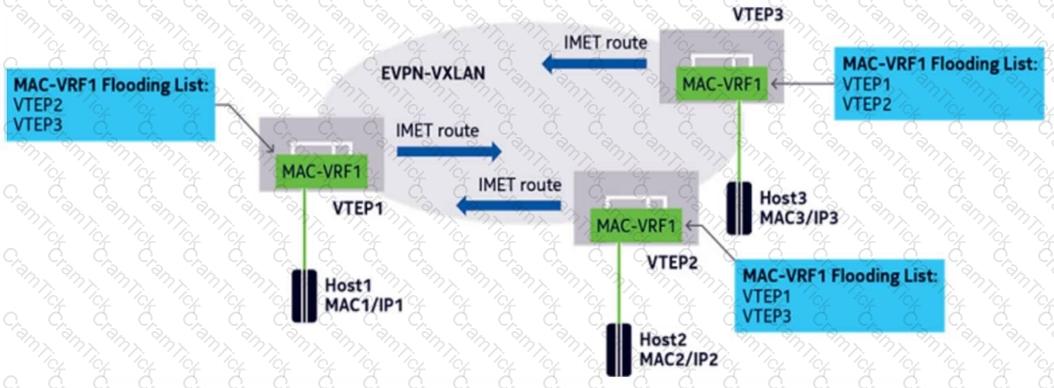Comprehensive and Detailed Explanation with Exact Extracts:
Option A (VNI is included): The IMET route explicitly carries the VNI (as the Ethernet Tag ID) to identify the Layer 2 domain.
"The IMET (Type 3) route includes the VNI (Ethernet Tag ID) to signal membership in a specific broadcast domain."
Option B (Flooding list is NOT included): The IMET route does not contain a flooding list. Each VTEP independently builds the flooding list by aggregating all received IMET routes for the same VNI (e.g., VTEP1 uses IMET routes from VTEP2 and VTEP3 to build its list).
"The flooding list for a VNI is dynamically constructed by each VTEP based on received IMET routes. The IMET route itself only advertises the sender's VTEP IP and VNI, not a pre-defined list of peers."
Option C (Route Distinguisher is included): The IMET route includes the MAC-VRF's Route Distinguisher (RD) to ensure uniqueness in the control plane.
"Every IMET route carries the MAC-VRF's RD to distinguish overlapping VNIs across different network instances."
Option D (VTEP IP is included): The IMET route advertises the VTEP's IP address (via the PMSI Tunnel attribute) to establish the BUM traffic tunnel endpoint.
"The IMET route includes the originating VTEP's IP address in the PMSI Tunnel field. This IP is used as the destination for VXLAN-encapsulated BUM traffic."
Exhibit Analysis:
The IMET routes (advertised by VTEP1, VTEP2, VTEP3) are shown.
Each VTEP's locally configured flooding list (e.g., VTEP1: [VTEP2, VTEP3]) is derived from received IMET routes, not embedded in the IMET route itself.
[References:, Nokia EVPN-VXLAN Integration Guide., Nokia SR Linux Fundamentals Guide: Section "EVPN BUM Handling"., Nokia EVPN Configuration Guide., Nokia SR Linux Configuration Guide: Section "EVPN Routes"., Explanation:, The IMET route includes the VNI, flooding list, and IP address of the originating VTEP, but it does not include the route distinguisher of the VTEP’s MAC-VRF., ]




